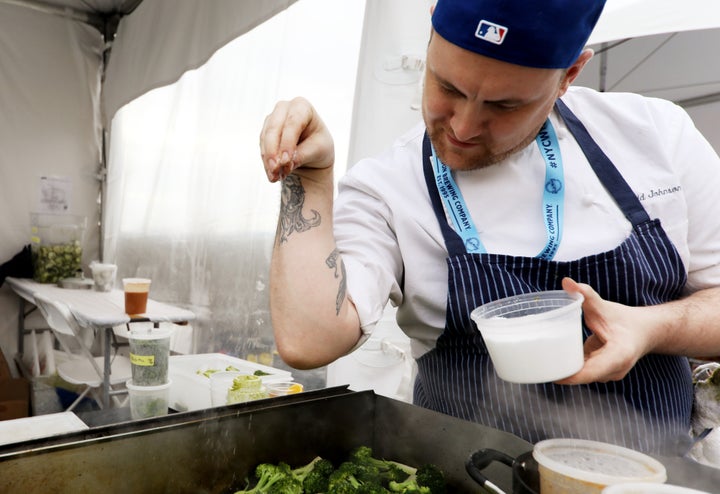
If you’ve wondered how the chefs at your favorite restaurant always seem to make food taste so much better than your home-cooked versions, there’s at least one ingredient that can take some of the credit — salt.
Of course, you use salt exactly the way the recipe says, except for when it says “salt to taste,” and then you possibly just close your eyes and toss.
But chefs use salt frequently throughout every stage of the cooking process. They use different types of salt for different purposes, and they often use it much more liberally than you probably do. The result? Food that tastes — not salty — but just more like itself.
“The amount of salt — and butter — used in the restaurant world is much higher than the average home cook is used to,” Keith Sarasin, chef and owner of The Farmers Dinner and Aatma, told HuffPost. “Salting food is part of the process, and a good chef knows how to season. It’s an art form that takes a while to master.”
“Just a dash of salt brings all the flavors to the surface and makes them shine together,” said Pati Jinich, chef, cookbook author and host of PBS’ “La Frontera.” ”Home cooks can be afraid of oversalting, but in many cases undersalting leads to food that’s bland or lacks oomph.”
Ready to get the “oomph” back in home-cooked meals? Here are some top chef tips for salting food like a pro.
Timing is everything
The timing for when you salt can be just as important as how you salt, said these experts. With most dishes, that means you need to “season in layers,” Jinich said, alternating sprinkles and frequent tastings throughout the cooking process.
Be sure to take it slow and steady. “The most important thing to know about timing is not to add too much, too soon,” Allison Arevalo, owner of Pasta Louise in Brooklyn, said. “Add a little as you go, and keep tasting your food. And when you’re boiling water for pasta, add more salt than you think. I use two tablespoons per pound of pasta when I’m cooking at home. I have a friend who always asks her husband, ‘Did you salt the water Allison’s way, or your way?’”
“Don’t salt your proteins too early,” Herve Malivert, director of culinary affairs at the Institute of Culinary Education, advised. “If you salt too early before cooking, the protein will start to denature and cure. Thirty minutes before isn’t a big deal. If you want to marinate something, don’t salt it. You can marinate with other spices, and then season with salt right before you cook.”
“Chefs salt at every stage of cooking, and then we check one last time before serving, just to be sure,” said Renee Scharoff, chef and owner of Blonde on the Run Catering. “We love salt!”
Not all salt is the same
The type of salt is another factor that affects end results. Josiah Citrin, the two-star Michelin chef and owner of Mélisse, Citrin, Charcoal, Dear John’s and Openaire, said it may seem like the pros are salting up a storm, but the quality of the product makes a difference.
“It’s fair to say that because my kitchen uses high-quality sea salt, the level of saltiness is not as intense and requires a bit more,” Citrin said. “It’s important to use high-quality salts as often as you can.”
Kosher salt was the most common “everyday” salt used by these chefs, and Diamond Crystal was the brand they mentioned the most. “The flakes are consistent and make for good measuring,” said Curtis Stone, chef and owner of Maude and Gwen Butcher Shop and Restaurant in Los Angeles.
Michelle Bernstein, co-owner of Miami’s Café La Trova, mentioned fine sea salt as her favorite for baking. And, if you live in the right place, you can even shop for salt close to home. “I love supporting smaller salt makers,” Sarasin said. “I live in the Northeast, and we have access to regional salts that are always special.”
Chef John Sugimura, of Minneapolis-based Pinku Japanese Street Food, said his loyalty remains with the familiar navy blue cylinder.
“I never use anything except Morton iodized salt for all my recipes, including gyoza, sukiyaki and pickled vegetables,” Sugimura said. “If it was good enough for my chef-grandmother more than a hundred years ago, it’s good enough for me.”
Stone uses Morton, too, but only in one specific location: “In a good, old-fashioned salt shaker on the table,” he said.

Use a good finishing salt, but only at the very end
In addition to cooking salt, there’s finishing salt, which adds crunch and flavor to finished dishes like seared meat, chocolate dessert and salads.
“That perfect, salty crunch that you can get from an amazing specialty sea salt can truly take a dish from good to great,” executive chef and managing partner Robin Selden, of Marcia Selden Catering, said. Finishing salt is not used during the cooking process, but rather sprinkled on after everything is done.
Top picks among the chefs were Maldon, Smoked Maldon, Fleur de Sel and Espuma De Mar (Jinich’s favorite).
What about flavored salts?
Some of the chefs make their own flavored or infused salts in-house, and some buy blends from purveyors. Bernstein mentioned Cancale N. 11, a blend of fleur de sel, orange peel and fennel from La Boîte, a New York boutique spice purveyor. “They sell to the best chefs in the world,” she said.
Or you can follow the lead of Christine Pittman, founder of food blogs CookTheStory and The Cookful, and grind your own. “I use a good-quality sea salt that I grind down in the food processor to a size similar to table salt,” Pittman said. “I prefer sea salt instead of iodized salt, because it’s less processed and contains trace minerals.”
Jinich offered a time-saving tip that’s used in many restaurant kitchens: “Mix up the salt and pepper together in one container, and then you’re ready to go.”
Aim high!
If you want to add salt more like a professional chef, be prepared to stretch up on your tippy-toes now and then. “When it comes to seasoning with salt, achieving even coverage is the key,” Pittman said. “Chefs salt their food by sprinkling it from about eight or more inches above the food, which allows for the salt crystals to fall more evenly.”
Be dramatic, yes, but not overly so. “Chefs don’t perform like the Salt Bae,” Stone said. “That’s all for show.”
Parting thoughts
As you’re choosing salt and learning how to use it, keep in mind that “one salt does not fit all,” Selden said. In her catering company, she sometimes offers salt bars with different varieties at some stations, so people can taste the difference. “We do a summer tomato station with a salt bar and people go crazy,” she said. “They didn’t even realize it was a thing.”
Finally, “Don’t worry if your dish ends up a little too salty, Jinich said. “Add a slice of ripe avocado or fresh lettuce to the dish. Or tuck it all into a taco and it will be alright.”